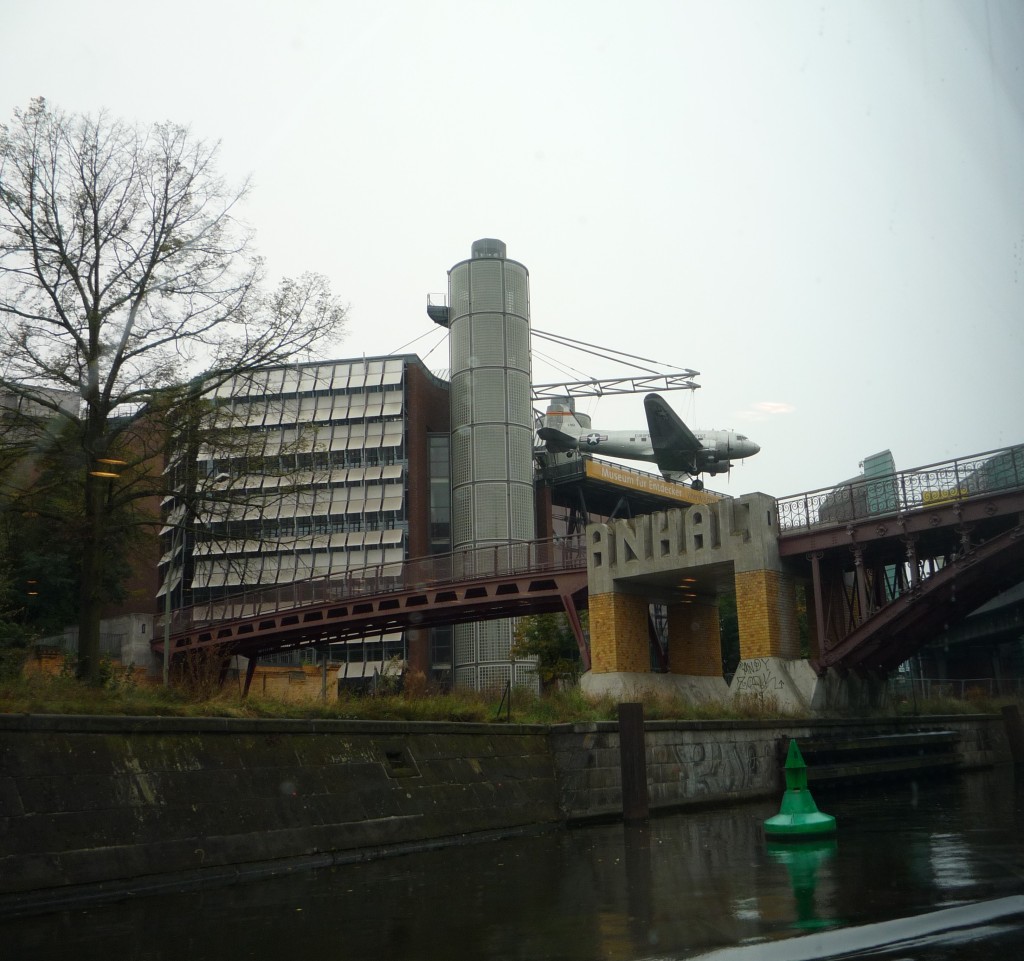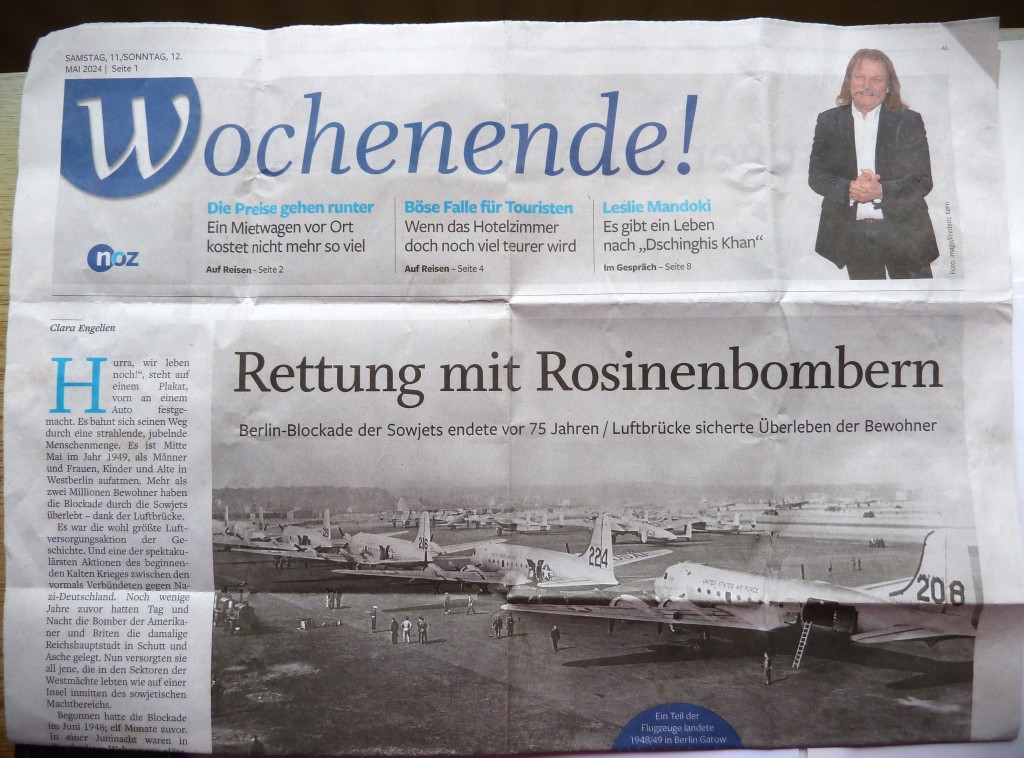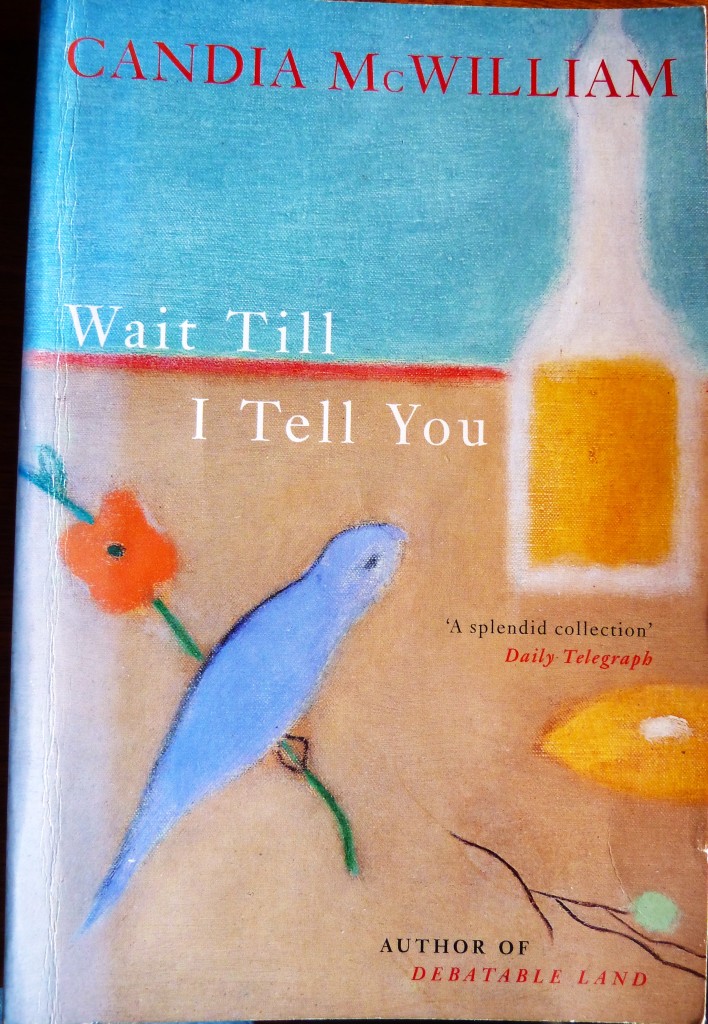22 May 2024 – Dr Sophie Louisa Bennett, PhD Conservation Biology (Lincoln 2016), MA Modern and Medieval Languages – German and Swedish (KC 1987, Cantab 2020), Diploma in Translation – German into English (City University/Institute of Linguists 1998)

ALLIES TO THE RESCUE AGAIN
How the airlift by the Western powers ensured the survival of the people of West Berlin during the blockade of 1948/1949
The Wochenende (Weekend) section 11th/12th May 2024 of the ever-excellent NOZ, the broadsheet of choice for friends of mine on the outskirts of Osnabrück, carried a feature by Clara Engelien marking the anniversary of the Berlin blockade. I was aware of this historical event but knew really very little about its details. Marianne and Wolfgang supplied the feature for my continuing education… Ever the unfinished article!
The Western Allies worked together in creating a ,,Luftbrücke” (literally: air bridge) to supply West Berlin with essentials in defiance of the Soviet operation. Supplies were airlifted to Berlin from the West by the Americans, supported by the British. The blockade was imposed by the Soviets, still under the dictatorship of Joseph Stalin, in 1948, in an attempt to take the whole of the eastern part of Germany, most of which they governed, barring West Berlin. It was a fairly obvious effort to force withdrawal of their former allies from the West. The blockade was negated by the actions of those allies, as thousands of flights kept Berlin’s population going and their former wartime opponents used their bombers in friendship rather than enmity.

As indicated, the newspaper cutting – a whole side of this local broadsheet – was sent to me by regular readers. Wolfgang, so Marianne had written to me in the accompanying greetings card, remembers this momentous period, the blockade and the aircraft, from his childhood. When I think of these two, and my parents who are of the same generation, almost exactly the same generation – children of the 1940s, married in the late 1960s – I think of all the fears and hardships they and their parents (my) grandparents, must have endured. On different sides during a War that nobody really knew was coming. At least not in the ‘general’ population. Who have seen post-War decades full of both alarming and exhilarating developments. Exciting and terrifying. In unequal measure.

Translation by Sophie Louisa Bennett from the NOZ feature on the Berlin Airlift:
ALLIED AIRLIFT TO THE RESCUE (Rettung mit Rosinenbombern)
How the airlift by the Western powers ensured the survival of the people of West Berlin during the blockade of 1948/1949
“Hurrah, we survived, we’re still alive!” read the banner which had been fastened to the front of one car. The car was making its way through a crowd of joyful people in celebratory mood. It was mid-May 1949, when men and women, children and old people, could finally breath a sigh of relief. More than 2 million inhabitants survived the Soviet blockade thanks to the so-called ‘air bridge’, the airlift undertaken by their former allies in the West to bring supplies to the people of West Berlin.
This was reputed to be the biggest airlift in history. And one of the most spectacular events of the incipient Cold War between the former Allies who fought Nazi Germany. Only a few years previously the American and British bombers had devastated the capital of the Third Reich, bombarding the city day and night and laying it waste. Now they are providing supplies to all those who lived in the sectors of Berlin overseen by the Western powers – as if they were on an island, in the midst of a Soviet stronghold.

The blockade had begun in June 1948; 11 months previously. Suddenly overnight, one night in June, the lights in West Berlin went out, gas cookers too extinguished. The Soviets had blocked various access routes, they had cut off electricity and gas supplies, and brought deliveries of groceries to a standstill. Quite literally from one day to the next the city was cut off from the outside world. “They wanted to take Berlin and thought that the quickest way to achieve this would be to starve us out“, as Anita Stapel, who as a resident witnessed events at the time, explained to Germany’s Spiegel magazine.
WE WERE VERY AFRAID
The Western allies were evidently to be forced to withdraw their troops. “The fear that they would desert us, that we would fall into Russian hands, was immense“, says Gerhard Bürger, also able to recount from contemporary experience of events. the trigger seems to have been monetary reforms, as a result of which the D-Mark [old currency of West Germany prior to the Euro] was introduced. In the eyes of dictator Joseph Stalin a provocation.
In the opinion of the Soviets, Berlin should have remained exempt from the currency reforms. “Streets, railway lines and waterways are closed to us, but we have the air corridors,” was the conclusion at the time. There were three linking the West to Berlin: from Hamburg, Bückeburg (Hanover) and Frankfurt which were agreed by treaty after the War.
The driving force behind the airlift was US Military Chief Lucius D. Clay; whose initiative, approved by President Truman, launched the mammoth efforts by the Western Allies. Just over two million people lived in the western sectors of the city. On top of that, there were around 9,000 American, 7,600 British and 6,100 French soldiers and their dependants.

“We had no doubt that the Americans – once they undertook to do something – would do it. However, we had no concept of the scale“, recalled Berlin resident Gerhard Bürger. To serve West Berlin’s needs a minimum of up to 5,000 tons of supplies a day were required.
To manage this required planes to be brought over from Alaska, Honolulu, South-East Asia or Texas. In the beginning the airlift was planned to last 45 days, but demands on logistical capacity took on ever greater proportions. There were not infrequent problems with flight coordination, with overloading. Airspace which was too restricted, and, at the outset, only 2 routes for over 600 flight movements daily, made the undertaking significantly more difficult.
And so it was that a second runway was built at both Tempelhof and Gatow airports respectively. In addition, 19,000 Berliners built a new airport at Tegel in 85 days under the guidance of American and French engineers. Ultimately, an aircraft would land every 2 to 3 minutes at one of the 3 airports.

The constant droning hum of the supply planes gave West Berliners hope, even if the sound for some also brought back darker memories of the only recently ended Second World War. Despite this the people of Berlin referred to these aircraft affectionately as ‘Rosinenbomber‘, i.e. literally: raisin bombers [dropping food and grocery parcels which may even have contained the occasional treat or ‘exotic’ dried fruits. Strange to think that dried fruits could be seen as something special. But they were, due to continued rationing and supply shortages elsewhere in the post-War world, which lasted into the 1950s.]
The operations were associated with horrendous costs for the American and British taxpayers. Nonetheless, for the Western powers it was not only a question of ‘love they neighbour‘ towards their former enemies. It was about building a liberal democracy, with its associated freedoms. West Berlin acquired a symbolic role similar to that of Ukraine today. The whole World was looking on, and for the Western powers it was clear: if Berlin falls, West Germany would be next.
LOOK AT WHAT IS HAPPENING TO THIS CITY
This position was clarified, to take one example, in a speech by West Berlin’s then Oberbürgermeister [Mayor] Ernst Reuter (SPD) in September 1948 as he stood before the ruins of the Reichstag parliamentary building. In his address to hundreds of thousands of audience members he declared: “I am calling on the People of the World, the People of America, England, France, Italy! Look upon this city and recognise that you should and must not abandon either the city or its people!” Attempts at a diplomatic solution remained unsuccessful for quite some time. A counter-blockade by the Western powers in the summer of 1948 had already blocked transport of goods from the West into the Soviet zone of occupation. Later this blockade was extended to trade with eastern European countries. The blockade simply became too expensive for the Soviet Union, and the Western Allies had amply demonstrated in any case that they would not allow annexation by the Soviets. On the 4th May 1949 the Soviet government caved in, a week later the blockade and counter-blockades ended.
The fact that during these operations American, English [British] and Germans worked side-by-side, to make possible the seemingly impossible, is an experience that characterised transatlantic relations over a sustained period. Ultimately, more than 2 million tons of goods were transported to Berlin, including more than 10 million food parcels. the 277,000 plus flights ensured survival of the inhabitants. “Under such circumstances you remain grateful your whole life. Which is only right,” according to Anita Stapel in the Spiegel magazine interview. “And also the very fact that somewhere in the World there are people who show their former enemies generosity.”
[Indeed, very remarkable that we were still prepared to help our former enemies, albeit there were thousands of Allied personnel and their families there. I cannot imagine what it must have felt like to be surrounded in this way by an enemy state with unpredictable intentions and I am proud that ‘Little Britain’, with its ‘inward-looking’ mentality, stepped in alongside the USA.]
A note at the end of the German text in the NOZ feature reads NKA – Not having researched this I assume that the feature writer, Clara Engelien, provided/used some syndicated materials from a press agency, and, evidently, materials from Spiegel magazine were also drawn from.

Regarding Rosinen – My copy of the 1954 Brockhaus monolingual German dictionary indicates that apart from them being ‘dried grapes‘ or ‘dried fruits of the vine‘ there are one or two idioms in which they are used: ,,Rosinen im Kopf haben” – is defined as ,hoch hinaus wollen‘ in this 1954 edition which translates literally as ‘wanting to go high up or achieve great heights‘, more recently though it has acquired the meaning of having lots of ‘big’ ideas which cannot be fulfilled or remain unfulfilled. Another expression is ,,die Rosinen aus dem Kuchen picken/klauben’‘, meaning ‘to pick all the best bits out for yourself‘ (!). I am not sure that these expressions have any relevance in the case of the coining of the word ,,Rosinenbomber“, but are interesting as background nonetheless. I can imagine children and adults alike waiting for the arrival of the aeroplanes from the West and watching as the small black dots on the horizon became bigger and bigger as they came properly into view. Perhaps the Allies and the Germans themselves were very unsure whether the airlift would work. But it did.

All translated material, plus additional comments [including square brackets] by Dr Sophie Louisa Bennett – and I/she reserves all rights on those materials. And, yes, despite everything, she is proud to be British – English in fact.















